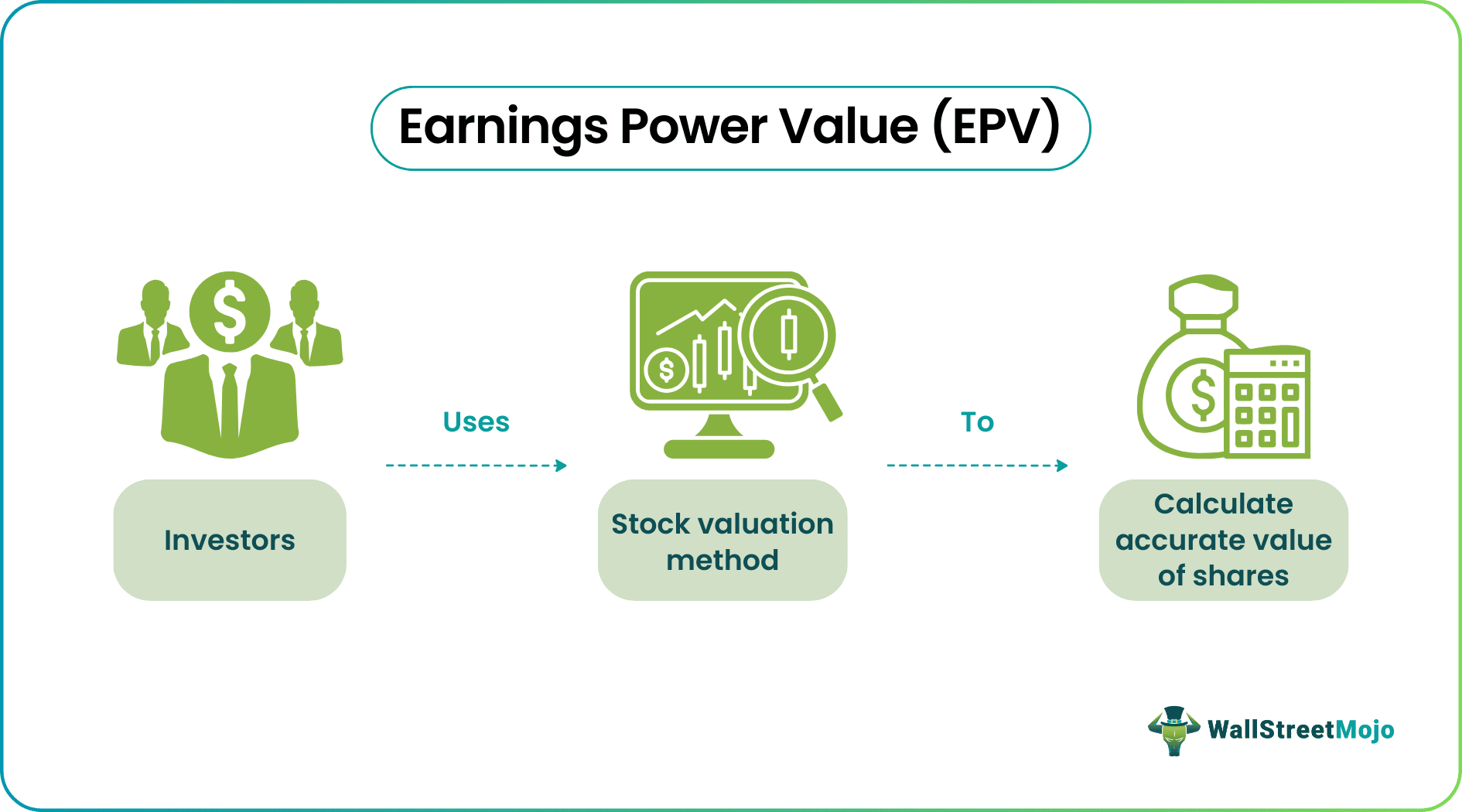Table Of Contents
What Is Earnings Power Value (EPV)?
Earnings Power Value is a stock valuation tool that assesses whether the shares of a company have been accurately valued. It determines a share's earning power by examining a company's long-term earnings and projecting average profits or current cash flows while checking all potential business scenarios for sustainability and respective adjustments.

Its capacity to offer a long-term view of a company's value is what makes EPV valuable and significant. It is helpful for valuing established, steady businesses with consistent earnings. Investors and analysts can evaluate a company's appeal as an investment opportunity and comprehend its essential earning potential with the aid of EPV.
Key Takeaways
- Earnings power value serves as a tool to evaluate the accuracy of a company's share price valuation. It utilizes a straightforward formula that considers the cost of capital and sustainable present earnings without factoring in growth.
- The formula for EPV is adjusted earnings divided by the weighted average cost of capital.
- It is important to note that EPV assumes consistent business operations and doesn't account for external or internal fluctuations that might impact production rates.
- The most important part of the EPV calculation is maintaining capital expenditure, which covers both maintenance and improvement capital expenditure.
Earnings Power Value Explained
Earnings Power Value (EPV) is a tool to analyze the value of stocks. It is a method of valuation created by Columbia University's value investing specialist, Bruce Greenwald. Compared to discounted cash flow analysis, which is predicated on speculative growth assumptions, it is a more accurate technique for stock analysis. EPV employs a simple formula that accounts for the cost of capital and sustainable current earnings but does not account for growth.
Essentially, Greenwald earnings power value is based on the sustainability of current profitability and minimal growth. It implies that a business will do precisely the minimum amount of effort to maintain its current profit margins, guaranteeing that the same profit will be made year after year in the future. This strategy is complicated for big businesses because it's hard to hold onto their present market share.
Businesses need to make sure there is enough capital expenditure (CapEx) invested back into the business in order to sustain present profit levels. Capital investment is used to expand and modernize already-existing operations, with future growth being the goal of expansion and maintenance of current profit levels for modernization. Maintaining capital expenditure is the critical component of the EPV calculation, and it includes capital expenditure for improvements and maintenance.
Formula
A company's adjusted earnings are divided by its weighted average cost of capital (WACC) to get EPV.
EPV = Adjusted Earnings / Weighted Average Capital Cost (WACC)
Operating earnings or Earnings Before Interest and Tax (EBIT), which are not adjusted for one-time charges, come first in the calculation of EPV. To calculate normalized EBIT, average EBIT margins across a minimum of the five-year business cycle are multiplied by sustainable revenues. The excess depreciation is added and multiplied by (1 - average tax rate).
After that, the analyst modifies this number to take pricing power, unconsolidated subsidiaries, ongoing restructuring costs, and other significant items into consideration. The adjusted earnings figure is divided by the weighted average cost of capital of the company to calculate EPV business operations. Earnings power value spreadsheet can also be used to streamline calculations.
Examples
Let us consider a few examples to understand the concept better.
Example #1
Daisy, an investor, uses EPV to find out if the investment is worth it. She does it using the formula and not an EPV calculator.
The weighted average cost of capital is 10%.
Adjusted Earnings: $5 million
Step 1: Calculate the EPV
EPV = Adjusted Earnings / WACC
EPV = $5 million / 10%.
EPV = $5 million / 0.10
= $50 million
Daisy determines the company's EPV, in this case, to be $50 million using adjusted earnings and a 10% WACC.
Daisy receives an estimate of the intrinsic worth of the earnings power of the company from the earnings power value model she created. She can assess if the investment opportunity seems undervalued or overvalued by comparing this value to the company's current market price. Daisy can use the WACC to reflect the desired rate of return and the company's earnings potential to make an informed investment decision.
Example #2
Warren Buffet is known to be one of the most famous wealthy investors. He is known for investing in shares of value. As a seasoned investor, he considers a great deal of factors when choosing stocks, and one such criterion is CapEx. It is relevant to EPV and investment as it impacts a company's earnings power.
In the book Warren Buffett and the Interpretation of Financial Statements by David Clark and Mary Buffett, which talks about how Buffet interprets financial statement, the expert indicates how higher CapEx may reduce earnings and affect the sustainability of earnings, ultimately influencing the estimated EPV. Hence, he suggests investors to consider a company's CapEx plans to assess its potential impact on future earnings and the resulting EPV, helping to make informative investment decisions.
Limitations
Some of the limitations of EPV are given as follows:
- The EPV metric assumes constant business operations and does not consider external or internal fluctuations that may affect production rates.
- This model does not account for business risks that could have an impact on the company's operations, such as supply chain issues, macro variables, workforce issues, or regulatory requirements.

